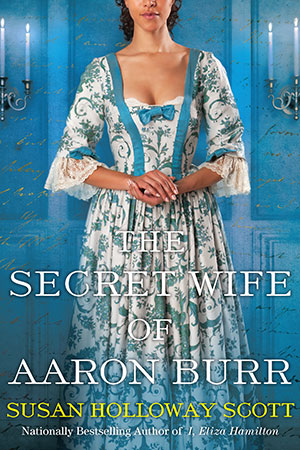Susan reporting,
For those of us who knit, embroider, crochet, and sew, October is the get-serious month for finishing handmade gifts for the coming holiday season. But as hectic as that can be, there's also a special satisfaction in putting a bit of yourself into something you've created, a one-of-a-kind memento that links the giver and the recipient in a way that a purchased present never can. If you're a "maker," you understand.
My guess is that Elizabeth Schuyler Hamilton (1757-1854), the wife of Alexander Hamilton, and the heroine of my new historical novel
I, ELIZA HAMILTON, understood this, too. For 18thc American women of the elite class like Eliza, handiwork could be as practical as mending worn garments or stitching baby garments, or as extravagant as embroidery incorporating imported gold lace and silk thread. While nearly all women of Eliza's generation and social rank would have been taught at least rudimentary sewing and fancier needlework, for some it became a form of self-expression as well.
The objects these women created were a way that they proudly shared themselves, their accomplishment, and their love with friends and family. Often the most treasured of heirlooms are the quilts made in honor of a marriage, a tiny smocked infant's dress, or an embroidered mourning picture commemorating a lost parent.
Although there are no surviving written records of what needlework meant to Eliza, I suspect that it was important to her, and that not only did her practical and industrious nature mean that she was seldom without some bit of handwork, but also that she excelled at it. I've already shared examples of her needlework executed while she was in her early twenties: this embroidered
mat that surrounds her future husband's miniature portrait, and the
embroidered handkerchiefs that she made for their wedding. These are the work of talented stitcher who clearly relished her time with her needle.
This knitted pillow cover, however, tells a much different story. The cover is believed to have been made around 1854, shortly before her death at age 97. Although Eliza was said to have been sharp-witted to the very end of her long life, it's evident from this that age had taken its toll on her eyesight. It's telling that she chose to knit the cover rather than embroider. Knitting is a more forgiving craft that embroidery, and the repetitive motions of knitting are less demanding than the precision of a needle through linen.
Yet as a knitter myself, I look at this pillow cover and see what a challenge it must have presented. There are dropped, repeated, and twisted stitches, stitches that are mysteriously increased and others that disappear. The colored stripes aren't consistent, the rows irregular and misshapen. Instead of neatly mitering the corners and making a single, shaped square, the piece was done in strips that were sewn together, with woven ribbons sewn over the seams (perhaps by someone else helping with the completion?) to soften the awkward joinings. But despite all the mistakes, what I see most is the elderly Eliza's determination and persistence to
make something special for an acquaintance, no matter how difficult the actual execution must have been for her.
Fortunately the recipient understood, too. Britannia W. Kennon (1815-1911) was the great-granddaughter of Martha Dandridge Custis Washington, wife of George Washington. Britannia is a fascinating woman in her own right, and deserves a future blog post of her own. In 1848, Eliza and her daughter Eliza Hamilton Holley moved from New York to Washington, DC, and rented a house on H Street owned by Britannia. The three women, sadly, had much in common. All three had been widowed at relatively early ages: Eliza's husband Alexander had died at age 48 (approximately; his birthdate is uncertain) of wounds suffered in his duel with Aaron Burr in 1804; Sidney Holly had died in 1842 in his early forties, and Britannia's husband, Commodore Beverley Kennon, had been killed in a shipboard explosion in 1844, less than two years after their marriage.
Britannia took the legacy of her family's past seriously. The elegant house in which she lived, Tudor Place, had been built by her parents with an inheritance from George Washington, and the furnishings included many pieces that had belonged to the Washingtons at Mount Vernon. Britannia arranged and displayed these objects at Tudor Place, taking care to record the details about each on hand-written paper tags.
Eliza's knitted pillow cover joined Britannia's collection. Perhaps it earned its place there because Eliza, long before, had been friends with Martha Washington, or because her late husband's numerous accomplishments gave luster to her own name by association. Perhaps, too, Britannia cherished the cover simply from respect and regard for Eliza herself. Preserved with the pillow is a small clipped paper,
right, with Eliza's signature - "
Elizth Hamilton", and on the back is a label in Britannia's handwriting: "Made by/Mrs. Alexander Hamilton/a short time before her/death, for Mrs. Kennon."
Today Tudor Place Historic House and Garden is a National Historic Landmark, and open to the public; see their website
here for more information. Eliza's "knitted gift" is now part of Tudor Place's collections. Information for this post came from unpublished sources from the Tudor Place archives, and from an annotated edition of Britannia W. Kennon's reminiscences that currently being compiled for future publication. Many, many thanks to Curator Grant Quertermous for his generous assistance with this post. And thanks, too, to Hannah Boettcher, Public Programs Coordinator, Museum of the American Revolution, for suggesting that I seek out Eliza's pillow cover.
Above: Pillowcase, made by Elizabeth Schuyler Hamilton before 1854. Linen, wool. Courtesy of Tudor Place Historic House & Garden.
Read more about Elizabeth Schuyler Hamilton in my latest historical novel, I, Eliza Hamilton, now available everywhere.









 One of us --
One of us -- 


